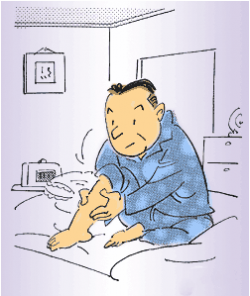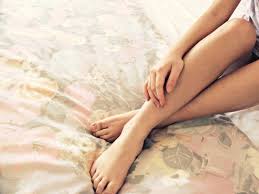As a disorder, Restless Leg Syndrome (RLS) is usually constant or progressive. A study published in the US National Library of Medicine shows, however, that transient RLS is experienced by a portion of individuals experiencing opiate withdrawal symptoms. Rather than continue throughout their lives as with some sufferers of RLS, the symptoms disappear along with the remission of other opiate withdrawal symptoms.
While not life threatening, restless leg syndrome is uncomfortable and irritating, as are the other symptoms of opiate withdrawal. If you are experiencing RLS from opiate withdrawal there are medications you can take and things you can do to cope.
In this article we will go through the symptoms of RLS, the medical treatments, and some natural coping strategies as well as offer you a timeline of withdrawal so that you know when you can anticipate your RLS symptoms to dissipate.
Symptoms

Rubbing your calves before bed may help alleviate your withdrawal-induced RLS.
Restless legs syndrome is characterized by an uncontrollable desire to move the extremities, especially the legs. The symptoms of this disorder worsen at night, and are very unpleasant especially in social situations.
According to Doctor Jaime Avecillas et al., the Symptoms of RLS include:
- Tingling, pricking, or burning feeling in the skin causing desire to move extremities (paraesthesias)
- Achy or crawling feeling in lower extremities
- Motor restlessness
- Sleep disturbances
- Periodic limb movements during sleep and relaxed wakefulness
Medical Treatments for Opiate Withdrawal Induced RLS
Restless leg syndrome during opiate withdrawal may be particularly unpleasant due to the existence of other withdrawal symptoms. An individual may be experiencing anxiety, nausea, intense sweating and runny nose, and a number of other symptoms along with RLS. There are some available medical treatments that can help alleviate restless leg syndrome. It is of note, however, that doctors generally try first to improve a patient’s sleep quality and alleviate underlying medical conditions before prescribing medications. Because of this and the transient nature of opiate withdrawal induced restless leg syndrome, natural remedies are favored.
Nonetheless, these medications are used to treat chronic RLS:
- Levodopa
- Pergolide
- Pramipexole
- Cabergoline
- Ropinirole
Natural Ways to Cope With Restless Leg Syndrome
As described above, medication therapies are not very widely prescribed, and it is recommended that patients first try other coping strategies to alleviate the symptoms of RLS.
According to the University of Maryland Medical Center and the Willis-Ekbom Disease Foundation, these lifestyle changes and at-home remedies will help:
- Change the temperature: This will require some experimentation to see what works for you. Some people with RLS report that taking hot baths helps them, while others prefer cold showers. Similarly, ice packs or heating pads have been known to help.
- Getting daily exercise: This has been said to significantly relieve symptoms, but not with intense exercise close to bedtime. Instead, moderate aerobic exercises are best.
- Doing calf stretches before bed
- Massage: Massaging the legs, especially just before bed, can be helpful.
- Applying pressure on the legs: Whether with bandages, a heavy blanket, hot or cold compresses, many people find that applying pressure to the legs before bed and while sleeping is helpful.
- Avoid caffeine, cigarettes, and alcohol: These foods are known to aggravate the symptoms of restless leg syndrome.
Timeline
The symptoms of opiate withdrawal induced RLS dissipate with the other symptoms of withdrawal. The physical symptoms of withdrawal only last up to a week, while the psychological symptoms such as anxiety and irritability can last for months. The symptoms of RLS appear to be both physical and psychological and can last for several weeks, or the duration of the psychological symptoms of opiate withdrawal.










